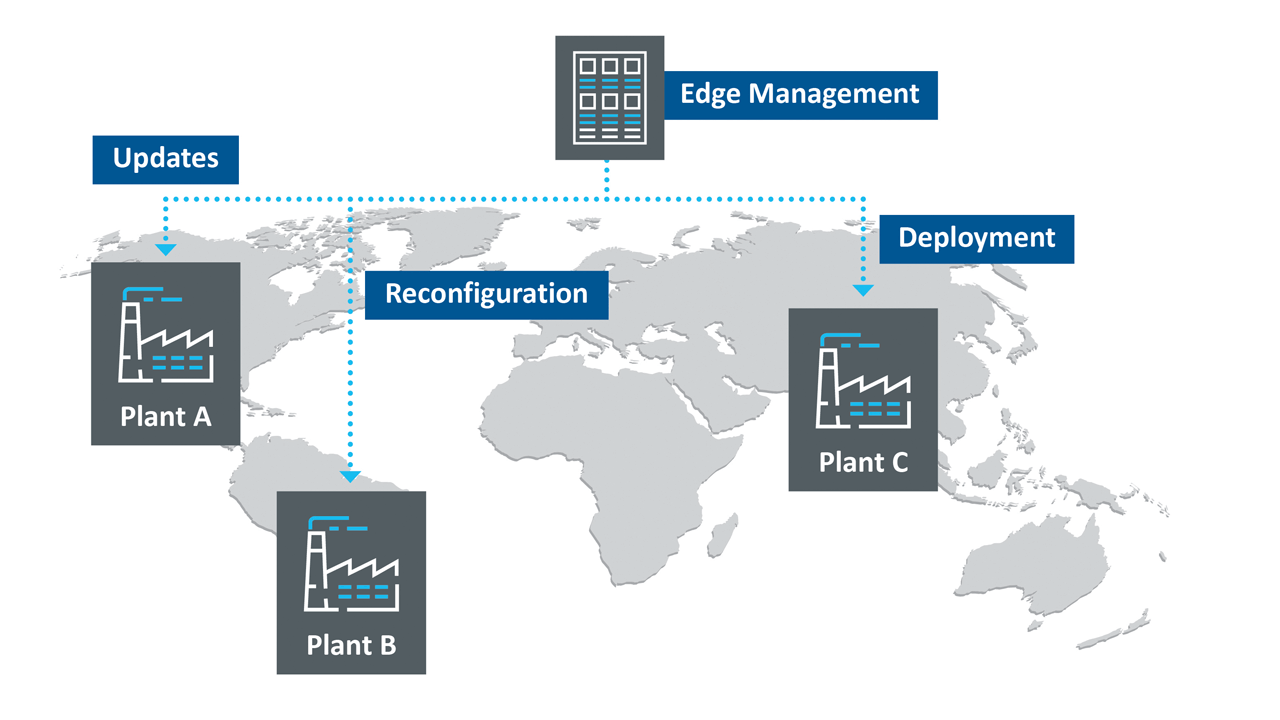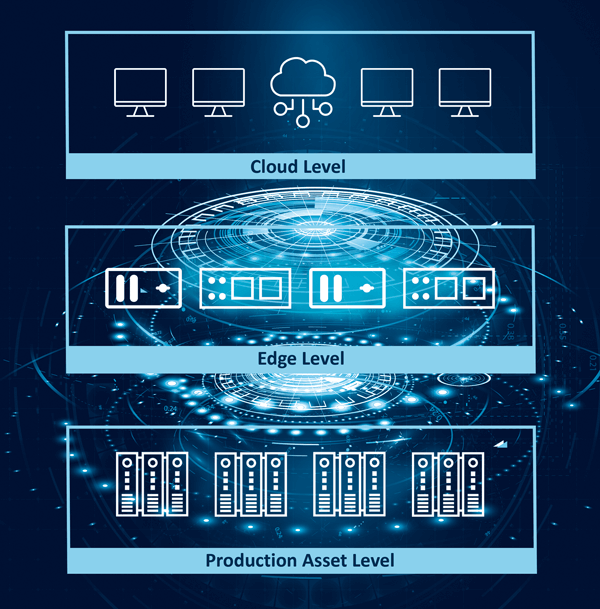TechnologyNovember 18, 2021
Benefits and potential of edge computing

Industrial edge computing can mean data are processed locally and never leave the site, or data can be forwarded for processing to a central platform. Hybrid systems with a mix of local and centralized data processing are the most common model used in practice but the key is potential advantages and benefits.
The word “edge” is bound to come up in any discussion about the Industrial Internet of Things (IIoT) and implementing an IIoT solution. But what does “edge” really mean in this context – and how is edge computing different to the more general principle of “local” or “on-site” data processing? What are the benefits and advantages users can enjoy from working with an industrial edge? And what are the key technical issues users should know about?
Edge vs. local

Centralized management of edge computing across sites delivers substantial efficiency gains.
Edge computing describes a decentralized approach to data processing, managed and operated via a central platform. These management and operation activities also involve deployment and software component updates, as well as their configuration or the handling of security certificates.
However, the term “edge” does not cover any plant equipment or software components that are operated autonomously and independently of a centralized platform. This is essentially the definition given in the recent white paper “Edge Computing in the Context of Open Manufacturing” by the Open Manufacturing Platform (OMP)1.
This means that “edge” is applicable only in the context of a centralized platform, unlike the more general use of software “local” to field devices. So the question is one of management and operations: centrally controlled or autonomous/site-specific? Where the data generated are processed is not critical, however: industrial edge computing can mean data are processed locally and never leave the site or, equally, the data can be forwarded for processing to a central platform. In fact, hybrid systems with a mix of local and centralized data processing are the most common model used in practice.
So the question becomes how does the industrial edge benefit users and what are the key advantages?
Efficient management & operations
Typically, a company’s production facilities will differ both in terms of the installed machine pool as well as the personnel and available local skills and expertise. In this situation, the centralized management of IIoT solution components deployed to each facility will reduce dependencies on local circumstances while reducing the need for per-site capacity building in terms of IT competencies. So, in many cases, deploying an industrial edge platform holds out the promise of improving the efficiency of solution operations.
Edge deployment may even be a precondition for the multi-site rollout of an industrial IoT solution. The magnitude of potential efficiency improvements also stems from the fact that IIoT solutions evolve dynamically over their lifetime – meaning adjustments and configuration changes at the edge are to be expected.

Cloud Level, Edge Level and Production Asset Level as defined by the Open Manufacturing Platform.
Use of standard hardware & tools
Software virtualization technologies – especially those using containerization – are an important part of edge computing. Docker containers at the edge are one example and are now supported by standard services from most of the major cloud services providers. Independently of cloud service provider tools, there are also many software systems available for the orchestration of these container-based solutions – such as Kubernetes.
In particular, an industrial edge architecture means that connectivity can be implemented as a software component and operated, like any other industrial edge component, on standard hardware. This reduces or even removes the need to deploy specialized, hardware-based connectivity solutions. Taken together, these two benefits of the industrial edge – leveraging standard IT technologies plus centralized management – help to ensure that users can complete an efficient multi-site rollout while simultaneously reducing their operating costs for this solution.
What does the industrial edge look like from a technical perspective and which architecture issues do users need to be aware of?
Functional components industrial edge
For some IIoT applications, which simply need to collect and analyze their data on a central platform, the industrial edge deployment will be focused only on connectivity. This connectivity architecture can be extended, however, to enrich the OT interface and include semantic information – by using OPC UA information models, for example.
Many IIoT applications will also require machine-level data processing: either because the volume of data generated is simply too large to be transferred in bulk to a central (cloud) platform or because latency times have to be kept short for a particular application.
This more advanced industrial edge platform will include functionality for connectivity and semantic data provisioning, as well as application-related functions. The individual components located at the edge will typically communicate via a bus system. Alongside these application components, an industrial edge platform also provides a set of functions – including monitoring, logging, and IT security services – that ensure the efficient operation of the solution throughout its lifetime.

Application view of an industrial edge as defined by the Open Manufacturing Platform.
Open architecture and standards
From a user perspective, an IIoT solution should be flexible, should make it as easy as possible to integrate components from several manufacturers, and should be extensible during its entire service life. Even in cases where users have decided to utilize one of the major cloud platform providers, they are often still interested in maintaining their independence from this provider wherever possible.
Accordingly, software architectures for the industrial edge should be open and based on available standards. Examples of such standards include OPC UA, MQTT (i.e. an MQTT broker at the edge), and Kafka for streaming between edge and cloud. Many open-source initiatives support these kinds of setups, with some also providing ready-to-use software components.
Information models and semantics
One key issue that has yet to be properly addressed by commercially available products and standardized models is the question of how the semantic information provided at the edge or production asset level (typically from OPC UA) can be effectively used within the cloud to drive AI and machine learning. This topic is now being addressed by current R&D activities, with successful solutions looking to offer significant simplification and efficiency gains for the implementation of AI-based IIoT solutions.
One example worth noting this context is an initiative targeting the simple deployment of OPC UA information models via a cloud-based database. The OPC Foundation and CESMII are currently part of a joint working group developing specifications for an “OPC UA Cloud Library”.
The information models will be deployable within the cloud or at the edge, and the aim is to simplify the integration of components from multiple manufacturers in a single IIoT solution while exploiting the full potential of the OPC UA standard.
IIoT solutions between store floor, edge and cloud
Addressing these technology and market trends, Softing developed and introduced the new edgeConnector family of container applications enabling customers to integrate their production into a comprehensive Industry 4.0 environment. The individual products each access the data of the controllers from different manufacturers via Ethernet or proprietary PLC protocols, using OPC UA (Open Platform Communications Unified Architecture) and MQTT (Message Queuing Telemetry Transport) as the main communication protocols for data transfer and integration.
The product family includes EdgeConnector Siemens, a software module that can read process and machine data via proprietary interfaces from Siemens controllers and make it available to IT via standardized interfaces. As a Docker container, it can be easily managed from a central platform. Two more Docker containers have also become available: edgeConnector 840D and edgeConnector Modbus.
All edgeConnector products feature a built-in web interface for configuration, and an API for configuration via third-party applications. Additional container products are currently being developed, including an OPC UA aggregation server and modules for collecting device data for asset management and asset monitoring applications.
As part of a set of customized solutions, Softing also offers its own Multi Factory Device Management System tailored to shop floor requirements. This enables Softing to independently design and implement architectures and IIoT solutions between shop floor, edge and cloud based on individual customer requirements.


